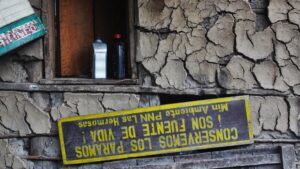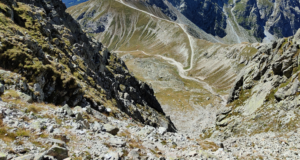ID84: Recreation and alpine wildlife
Details
Full Title
Recreation and alpine wildlife: insights, knowledge gaps and ways on how
to minimize negative impactsScheduled
Wednesday, 2022-09-14
18:30-20:00Convener
Co-Conveners
Martin Wyttenbach and Reto Rupf
Assigned to Synthesis Workshop
–
Keywords
Recreation ecology; outdoor recreation; environmental impact; disturbance;
alpine wildlife; mountainous areas
Description
In many parts of the world, mountainous areas are popular for a wide range of outdoor recreational activities such as hiking, mountain biking, trail running and skiing. Such activities are carried out more and more in remote, natural areas which are often protected and of high biodiversity value. With an increase in leisure time, more people travelling to mountainous areas and social trends, the diversity of these activities has increased, which results in a growing pressure on sensitive wildlife. This session is designed to bring together scientists from different disciplines, such as biology and recreation ecology and practitioners, such as managers of protected areas and awareness-raising campaigns. We will discuss the state-of-knowledge on the effects of recreation on wildlife, future research directions and ways on how to minimize impacts of recreation so that evidence-based schemes can be implemented to mitigate human-wildlife conflicts.
Registered Abstracts
Abstract ID 697 | Date: 2022-09-14 18:30 – 18:46 | Type: Oral Presentation | Place: SOWI – Seminar room U3 |
Marpot, Stephane; Chanteloup, Laine; Perrin-Malterre, Clemence
Université Savoie Mont Blanc / Edytem, France
Keywords: Emotions, Human-Alpine Wildlife Relationship, Nature Sport Practices, Sociology, Ethnography
By affecting our cognition, emotions play an important role in our perceptions towards wildlife. They represent a key aspect to understand human-nature relationships both socio-culturally inherited and environmentally experienced. However, the researches show nonetheless a lack of qualitative long term sociological research. Taking part in my PhD research, this study aims to analyzing the perceptions and emotions towards mountain environment and wild animals through recreational activities. Mixing a microsociological approach (inspired by Barbara Humberstone) and an ecological anthropology (as developed by Tim Ingold), the purpose of this study is to understand how outdoor sports recreationist’s emotions shape relationship between nonhuman animals and humans when people experience mountain environment, especially when encountering wild animals.
This study relies on thirty biographical semi-directive interviews with hikers and skiers selected for the diversity of their sociological profiles and their practices. They all visit french alpine massifs and more particularly the Bauges, Belledone and Vanoise. This method leads to narratives that reveal what disposes recreationists to subjectively see and feel wildlife. In addition, participant observations have been made to share and grasp bodily and in an immersive way the affective dimension of mountain’s raids and crossings with some of them. Enable to identify how emotions are rooted and expressed, in conjunction with these approaches, we use photo elicitation interviews to explore respondents own theories of interspecific emotions.
In a first attempt to characterize these relations, sociologists argued that the recreationists seek to transform their lives, in a search of wilderness. Encounters with ibexes, chamois, groundhogs and others wild animals are often presented as the acme of the experience of nature. Nevertheless, ethnographical inquiry and discourses gathered during interviews reveals other perspectives. Indeed, emotions implied by these interspecific relations appear to be more versatile and ambiguous. Mostly appreciate as unexpected events, irruptions of wild animals are mostly described by combining three components. Firstly, they are shown as subjects with multisensory bodies taking part of mountain’s atmosphere. Secondly, recreationists consider them as more or less disturbed inhabitants belonging to mountain. Last, but not least, they are others or unknowns whose behavior engages a learning process with humans.
Then, these frames of perceiving wildlife can shift the experience of mountain spaces by offering various sensitivities and uncanny affectivities switching between fascination and anxiety. Finally, by informing the affective dimension of human-wildlife experiences, we expect to improve how we can raise awareness of a growing and diversifying mountain public.
Abstract ID 469 | Date: 2022-09-14 18:46 – 19:02 | Type: Oral Presentation | Place: SOWI – Seminar room U3 |
Hochreutener, Adrian; Wyttenbach, Martin; Rupf, Reto
Institute of Natural Resource Sciences, Zurich University of Applied Sciences, Switzerland
Keywords: Recreation Ecology, Outdoor Activities, Wildlife, Mountainous Areas, Disturbance
Outdoor recreational activities such as hiking and mountain biking, are increasingly popular in many parts of the world, especially in mountainous areas. In the context of a systematic literature review we assessed the latest research on the impacts of these activities on mammals and birds in mountainous areas on a global scale. Most research was conducted in Europe (52%) and in subalpine habitats (49%) such as open forests. Impacts from recreational infrastructure (51%) were more frequently assesses than those from activities and most research was conducted in summer (47%). Ninety-one percent of the included research documented significant effects of recreation, which were negative in 82% of all cases. We found most evidence for negative effects related to infrastructure, such as ski-lifts and (hiking)trails. Research at community level was rare (7%) but negative impacts on populations (40%) and individuals (42%) were well documented. They included reduction of habitat and changes in behaviour. To minimise impacts of recreation on wildlife, research proposed a wide range of measures. They included conservation strategies implemented at landscape scale, habitat improvement, spatial restrictions such as wildlife sanctuaries and visitor education. While the effects of infrastructure and non-motorized activities such as hiking are well understood, there is a significant knowledge gap when it comes to the effects of increasingly popular activities, such as mountain biking and electric mountain biking. Further, there is limited knowledge on the awareness of recreationists and their ability to plan tours that minimally impact wildlife. To close this knowledge gaps, we invite researchers to conduct further studies including a diverse range of activities as well as responses of wildlife on population and community level. With this knowledge, managers of mountainous and protected areas can introduce effective schemes to reduce the negative effects of recreation on wildlife and recreationists can be sensitized.
Abstract ID 481 | Date: 2022-09-14 19:02 – 19:17 | Type: Oral Presentation | Place: SOWI – Seminar room U3 |
Chanteloup, Laine (1); Dellier, Julien (2); Bailly, Noémie (3)
1: Université de Lausanne, Switzerland
2: Université de Limoges
3: Université Savoie Mont-Blanc
Keywords: Hunting Practice, Wildlife Value Orientation, Large Predators
The diversification of recreational practices in the mountains, coupled with socio-economic and cultural transformations, have changed the relationship with hunting in Western societies. Today, this activity represents a very specific recreational practice with regard to wildlife, insofar as it is both a tool for managing wildlife populations and a form of nature experience that allows people to get to know and get closer to animals (Stepanoff, 2021). This communication presents the results of a questionnaire survey conducted among more than 2300 mountain hunters in the French Alps, coupled with about 30 semi-directive interviews. Using the Wildlife Value Orientation scale (Fulton et al., 2008), which allows us to capture different positions ranging from animal dominance relationships to mutualistic values, we question the values expressed by hunters towards animals. Contrary to other surveys conducted internationally on this type of public (Gamborg et Sondergaard Jensen, 2016), the respondents seem to be close to mutualist values in their relationship with wildlife. However, this position can be called into question when the widely decried issue of the presence of large predators is included. We will deepen the analysis on the discourse on these animals to have a better understanding of this ambiguity.
Abstract ID 956 | Date: 2022-09-14 19:17 – 19:33 | Type: Oral Presentation | Place: SOWI – Seminar room U3 |
Aschaber, Andreas (1); Ravnik, Jurij (2); Bloudek, Jan (1); Berkmann, Ulrich (3); Trpovski, Vladimir (4); Lukesova, Anna (5); Jandik, Petr (6)
1: European Union of Mountaineering Associations, Belgium
2: PZS, Slovenia
3: DAV, Germany
4: FPSM, North Macedonia
5: CUNI, Czech Republic
6: CHS, Czech Republic
Keywords: Rock Climbing Areas, Climbing Area Management System, Sustainable Rock Climbing Sport, Environmental Protection
Climbing is one of the oldest human activities. Scaling mountains and overcoming vertical challenges has been present throughout human history. Usually, the motivation for this activity was derived from exploration, science and conquest. Around the end of 19th century, climbing gained popularity as an adventurous activity, which slowly shifted towards a more sportive orientated activity. This trend kept evolving and developed into today’s disciplines like sport climbing, trad climbing, bouldering and competition climbing which made this mountain sport available for everyone.
Today, rock-climbing is well recognized and established in the world. With the rise of popularity, many new challenges and issues emerged. Foremost, rock-climbing takes place in nature, where problems aroused in connection with nature protection. Rock-climbing affects the animals, plants, and, of course, geological structures. Most of the animals and plants which can be found in rock-climbing areas, are adapted specialists and extremely vulnerable. The nature experience during the climbing activity depends to a great extent on an intact nature environment and, on the long run, serves for our sustainable human livelihood.
Based on a social-cultural point of view, climbers were early stigmatized as disrespectful grungy looking guests who are doing drugs, bringing little money, and leaving many problems. The social and environmental components of rock-climbing lead to a complex conglomeration of conflict of interests. Apart from this, rock-climbing also affects cultural heritage sites as well as religious and spiritual sites. Although some conflicts have eased, the need for sustainable management of rock-climbing areas is today even greater due to increased visitor pressure.
In the framework of an EU project, an attempt was made to create an official definition of rock-climbing and its disciplines. This was accomplished by an international expert group to create the most appropriate transversally valid definition. The study also investigated all possible areas where rock-climbing has an impact, especially on the environment. A major backbone of the project was an extensive survey which was distributed to the major rock-climbing associations in 29 European countries. The analysis revealed which interest conflicts are prevailing in connection with climbing and how prominent they are. The study highlights viable elements on which a sustainable rock-climbing area management should build. Three case studies of successful rock-climbing area management systems give a holistic example of how a structured approach to visitor guidance could lead to a win-win situation for the majority of the involved stakeholders.
Abstract ID 786 | Date: 2022-09-14 19:33 – 19:49 | Type: Oral Presentation | Place: SOWI – Seminar room U3 |
Gruas, Léna (1,2); Perrin-Malterre, Clémence (1,2); Loison, Anne (1,3)
1: Université Savoie Mont Blanc, France
2: EDYTEM
3: LECA
Keywords: Mountain Sports, Participants Profils, Environnmental Attitudes, Wildlife, Disturbance
The research we present here is based on a twofold observation about recreational activities in the mountains. On the one hand, there is a growing interest in nature sports, which brings more and more people into the natural environment each year. On the other hand, despite the proven negative consequences on the environment and particularly on wildlife (Larson et al. 2016), recreationists are not always aware of the consequences that their presence in nature may entail (Gruas et al. 2020). The aim of this study is therefore to examine the relationship between winter (ski touring and snowshoeing) and summer (hiking and trail running) recreationists and mountain wildlife. The analysis is based on four mountain ranges of the northern French Alps and on data collected by questionnaires and interviews.
Four research axes are developed. The first deals with the social origin of the participants. The second axis aims to analyze the different ways in which each sport is practised, as well as their possible affinities with the participants’ social groups. Although each sport has different styles of practice, these are not as obviously linked to the social origins of the athletes as one might have thought. These first two axes also highlight strong inequalities of access to mountain sports and their most committed modalities of practice for women. The third axis deals with the eco-responsible attitudes and behaviors of individuals outside of their sporting activities, in everyday life. The participants interviewed in this survey are indeed more concerned about the environment than the rest of the French population. However, there are marked differences within the sample, particularly according to gender and social background. The fourth axis is dedicated to the question of the relationship with wildlife. While gender and field of study partly influence the emotional bond with wildlife and knowledge of species, they do not explain the perception of disturbance and respect for tranquility areas, which are more closely linked to environmental values.
This structuralist analysis of mountain sports aims to propose an approach to the sociology of sports in the natural environment from the triple point of view of the practice of the sport, the relationship with the environment in which it is practised and the perception of disturbance of wildlife.



